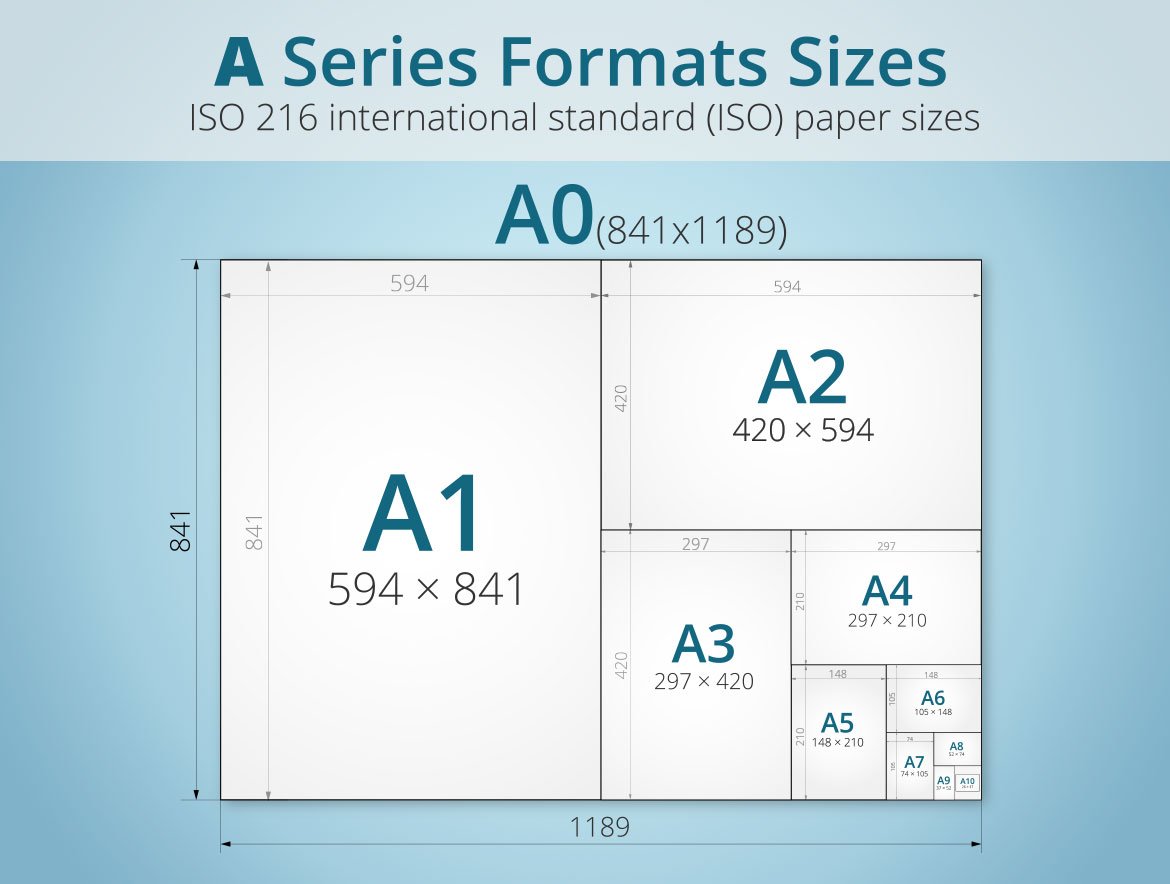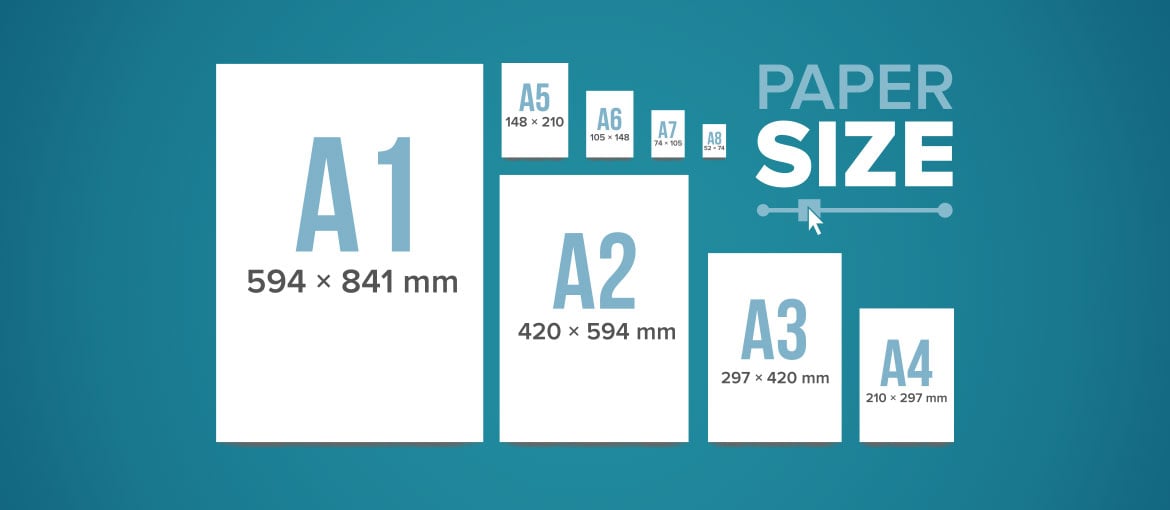Table of Contents
We bet that in your office there are reams of A4 in the printer and at least one A5 sheet full of notes somewhere on your desk. If you’re familiar with paper formats, you’ll have probably guessed that we’re talking about printer paper and notepads.
The list of paper formats is long and, to be honest, not terribly interesting. It’s all about numbers! In this post we want to present it in a more practical and, we hope, useful ‘format’. Sure, we’ll talk about paper sizes, but we’ll also look at their most common uses: posters, leaflets, brochures, postcards, books, business cards and more.
ISO 216 paper formats: a quick word about the standard
Let’s start with the most boring bit: the ISO 216 standard that classifies different paper formats based on the sheet’s dimensions to create an international standard. This allows all European countries (in the United States and Canada the Letter format rules) to speak the same language, at least as far as paper formats are concerned.
According to the standard, formats are generated by subdividing an initial sheet without leaving any waste material. In the A series, the most common, this great ancestor is the A0 sheet, which can be folded and cut to create all the other formats in the series. How is it folded? We’re not going to explain here, because then things would get really boring. Because, at the end of the day, you just want to know which paper format is best for your project, right?

In the A series, the ‘primary’ range, there are 10 subgroups: they go from A0, the largest format, to A10, the smallest. Alongside the A series are the ‘subsidiary’ B and C series, which are also denoted by numbers. What do ‘primary’ and ‘subsidiary’ mean? They mean that a letter written on an A4 sheet can be placed inside a C4 envelope, while a C4 envelope can be placed inside a B4 envelope. This is because a C4 sheet is slightly wider than A4 while B4 is slightly wider than C4.
If you’ve hung out in the publishing world, you will have heard of the B series, which goes from B0 (1000 x 1414 mm) to B10 (31 x 44 mm). In fact, B5 (176 x 250 mm) is a great format for books. B0 (1000 x 1414 mm), B1 (707 x 1000 mm) and B2 (500 x 707 mm), given their large sizes, are a good choice for printing posters or office presentations. And the C series, which goes from C0 (917 x 1297 mm) to C10 (28 x 40 mm), is the perfect ‘supplementary’ range, since it’s mainly used for creating envelopes.
A series. Formats, dimensions and uses.
Below you’ll find the dimensions and possible uses for each format. We say ‘possible’ because there are no rules that say a project must use a specific sheet size. There are, however, conventions. When you think of a postcard, for example, in your mind you see an A6 format. But there’s nothing to stop you from doing something different. You could, for instance, create a postcard of Lisbon in the shape of a sardine. But you would have to be willing to waste paper and pay steep printing costs given that we’re talking about a custom format in the shape of a… sardine! 😉
A0 format. Dimensions: 841 x 1189 mm.
This is the biggest format of all. Its large size means it’s only used by copy shops and designers, and the same goes for A1 and A2. A0 is mainly used for technical drawing, which requires sheets that are large enough for a design to fit comfortably, without having to use a magnifying glass. It can also be used for posters, although the most widely used formats for these are 700 x 1000 mm and 1000 x 1400 mm.
A1 format. Dimensions: 594 x 841 mm.
A1, which is also pretty large, is used for technical drawing too, as well as for maps, posters and other large-format advertising materials.
A2 format. Dimensions: 420 x 594 mm.
Applications for the A2 format are varied: from drawing to printing photos; from posters to charts; from large wall calendars to flipcharts.
A3 format. Dimensions: 297 x 420 mm.
Along with A4, this is undoubtedly one of the most common sizes. It’s therefore no surprise that most office printers can take A3 as well as A4. So, what’s it used for? It’s used to print drawings, artwork, posters, photos, magazines, musical scores, certificates and more. It’s also the perfect format for promotional leaflets (folded 6 ways): its generous size allows you to present a map of a convention centre or a many-branched diagram.
A4 format. Dimensions: 210 x 297 mm.
Everyone, even the uninitiated, knows that A4 is the classic paper size for printers and as such it is used for standard documents from letters to forms. It’s the format of school notepads, children’s books, encyclopaedias (which need more space for illustrations), magazines and leaflets. Indeed, the classic leaflet format is an A4 sheet folded in three.
A5 format. Dimensions: 148 x 210 mm.
The A5 format is also widely used. We started this article by saying that there would likely be an A5 notepad on your desk. A5 is in fact the perfect format for notebooks: it’s less bulky than A4, practical for taking notes and doesn’t take up too much space in a backpack. For the same reason, A5 can also be great for printing books, as well as magazines, leaflets and flyers.
A6 format. Dimensions: 105 x 148 mm.
You’re bound to be familiar with this format too, especially if you’re still in the habit of sending postcards from holiday destinations or accompanying gifts with a greetings card. Postcards and greetings cards generally come in A6 format. What’s more, the size of an A6 sheet is also perfect for printing leaflets and pocket diaries and books.
A7 format. Dimensions: 74 x 105 mm.
Given its compact dimensions, A7 can be used to create, for example, a mini calendar with the timetable for classes at a gym or school, as well as flyers or greetings cards.
A8 format. Dimensions: 52 x 74 mm.
To give you an idea of the A8 format, just look inside your wallet: business cards and loyalty cards are usually in a similar but slightly larger format (85 x 55 mm). So, there’s nothing to stop you from using this standard format for business cards, mini greetings cards, stickers or labels.
The table below summarises the dimensions of different formats in the A series. Dimensions are given in millimetres, centimetres, inches and pixels.
| Dimensions in millimetres
Height x Width (mm) |
Dimensions in centimetres
Height x Width |
Dimensions in inches
Height x Width (in) |
Dimensions in pixels
Height x Width (px) |
|
| A0 paper format | 1189 x 841 mm | 118.9 x 84.1 cm | 46.8 x 33.1 in | HR – 14043 x 9933px
LR – 3370 x 2384px |
| A1 paper format | 841 x 594 mm | 84.1 x 59.4 cm | 33.1 x 23.4 in | HR – 9933 x 7016px
LR – 2384 x 1684px |
| A2 paper format | 594 x 420 mm | 59.4 x 42 cm | 23.4 x 16.5 in | HR – 7016 x 4961px
LR – 1648 x 1191px |
| A3 paper format | 420 x 297 mm | 42 x 29.7 cm | 16.5 x 11.7 in | HR – 4961 x 3508px
LR – 1191 x 842px |
| A4 paper format | 297 x 210 mm | 29.7 x 21 cm | 11.7 x 8.3 in | HR – 3508 x 2480px
LR – 842 x 595px |
| A5 paper format | 210 x 148 mm | 21 x 14.8 cm | 8.3 x 5.8 in | HR – 2480 x 1748px
LR – 595 x 420px |
| A6 paper format | 148 x 105 mm | 14.8 x 10.5 cm | 5.8 x 4.1 in | HR – 1748 x 1240px
LR – 420 x 298px |
| A7 paper format | 105 x 74 mm | 10.5 x 7.4 cm | 4.1 x 2.9 in | HR – 1240 x 874px
LR – 298 x 210px |
| A8 paper format | 74 x 52 mm | 7.4 x 5.2 cm | 2.9 x 2.0 in | HR – 874 x 614px
LR – 210 x 147px |
| A9 paper format | 52 x 37 mm | 5.2 x 3.7 cm | 2.0 x 1.5 in | HR – 614 x 437px
LR – 147 x 105px |
| A10 paper format | 37 x 26 mm | 3.7 x 2.5 cm | 1.5 x 1.0 in | HR – 437 x 307px
LR – 105 x 74px |
B series. Formats, dimensions and uses.
Used far less in everyday life, B series paper is employed by professional printers to produce books, brochures, passports and more… The main difference compared to A series? A piece of B format paper will be slightly bigger than its A format equivalent with the same number.
Below is a summary table with the dimensions in millimetres, centimetres, inches and pixels for the various B series formats.
| Dimensions in millimetres
Width x height (mm) |
Dimensions in centimetres
Width x height (cm) |
Dimensions in inches
Width x height (in) |
Dimensions in pixels
Width x height (px) |
|
| B0 paper format | 1000 x 1414 mm | 100 x 141.4 cm | 39.4 x 55.7 in | HR – 11811 x 16701px
LR – 2835 x 4008px |
| B1 paper format | 707 x 1000 mm | 70.7 x 100.0 cm | 27.8 x 39.4 in | HR – 8350 x 11811px
LR – 2004 x 2835px |
| B2 paper format | 500 x 707 mm | 50.0 x 70.7 cm | 19.7 x 27.8 in | HR – 5906 x 8350px
LR – 1417 x 2004px |
| B3 paper format | 353 x 500 mm | 35.3 x 50.0 cm | 13.9 x 19.7 in | HR – 4169 x 5906px
LR – 1001 x 1417px |
| B4 paper format | 250 x 353 mm | 25.0 x 35.3 cm | 9.8 x 13.9 in | HR – 2953 x 4169px
LR – 709 x 1001px |
| B5 paper format | 176 x 250 mm | 17.6 x 25.0 cm | 6.9 x 9.8 in | HR – 2079 x 2953px
LR – 499 x 709px |
| B6 paper format | 125 x 176 mm | 12.5 x 17.6 cm | 4.9 x 6.9 in | HR – 1476 x 2079px
LR – 354 x 499px |
| B7 paper format | 88 x 125 mm | 8.8 x 12.5 cm | 3.5 x 4.9 in | HR – 1039 x 1476px
LR – 249 x 354px |
| B8 paper format | 62 x 88 mm | 6.2 x 8.8 cm | 2.4 x 3.5 in | HR – 732 x 1039px
LR – 176 x 249px |
| B9 paper format | 44 x 62 mm | 4.4 x 6.2 cm | 1.7 x 2.4 in | HR – 520 x 732px
LR – 125 x 176px |
| B10 paper format | 31 x 44 mm | 3.1 x 4.4 cm | 1.2 x 1.7 in | HR – 366 x 520px
LR – 88 x 125px |
C series. Formats, dimensions and uses.
C series paper formats are used more often than you might think.
They’re employed for the production of envelopes for letters. Indeed, if you think about it, an A4 sheet of paper will fit a C4 format envelope exactly. Likewise, a sheet of C5 paper will fit a B5 envelope exactly. So the C series is a “complementary” series designed to fit paper formats from the other two series.
Below is a summary table with the dimensions in millimetres, centimetres and inches for the various C series formats.
| Dimensions in millimetres
Width x height (mm) |
Dimensions in centimetres
Width x height (cm) |
Dimensions in inches
Width x height (in) |
|
| C0 paper format | 917 x 1297 mm | 91.7 x 129.7 cm | 36.1 x 51.5 in |
| C1 paper format | 648 x 917 mm | 64.8 x 91.7 cm | 25.5 x 36.1 in |
| C2 paper format | 458 x 648 mm | 45.8 x 64.8 cm | 18.0 x 25.5 in |
| C3 paper format | 324 x 458 mm | 32.4 x 45.8 cm | 12.8 x 18.0 in |
| C4 paper format | 229 x 324 mm | 22.9×32.4 cm | 9.0 x 12.8 in |
| C5 paper format | 162 x 229 mm | 16.2 x 22.9 cm | 6.4 x 9.0 in |
| C6 paper format | 114 x 162 mm | 11.4 x 16.2 cm | 4.5 x 6.4 in |
| C7 paper format | 81 x 114 mm | 8.1 x 11.4 cm | 3.2 x 4.5 in |
| C8 paper format | 57 x 81 mm | 5.7 x 8.1 cm | 2.2 x 3.2 in |
| C9 paper format | 40 x 57 mm | 4.0 x 5.7 cm | 1.6 x 2.2 in |
| C10 paper format | 28 x 40 mm | 2.8 x 4.0 cm | 1.1 x 1.6 in |
As mentioned earlier, this is just a set of general rules. Feel free to break them!



